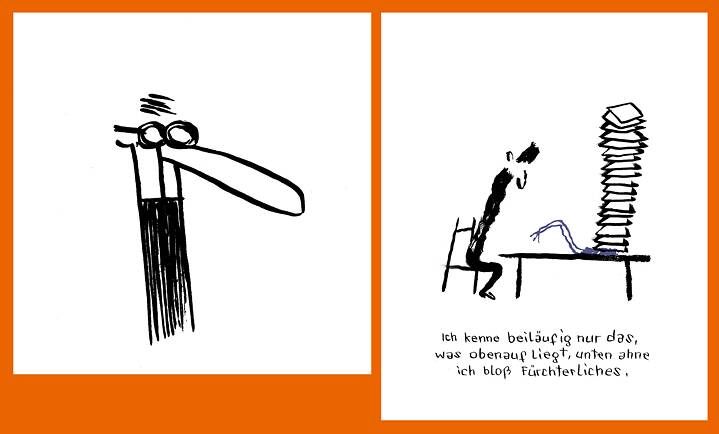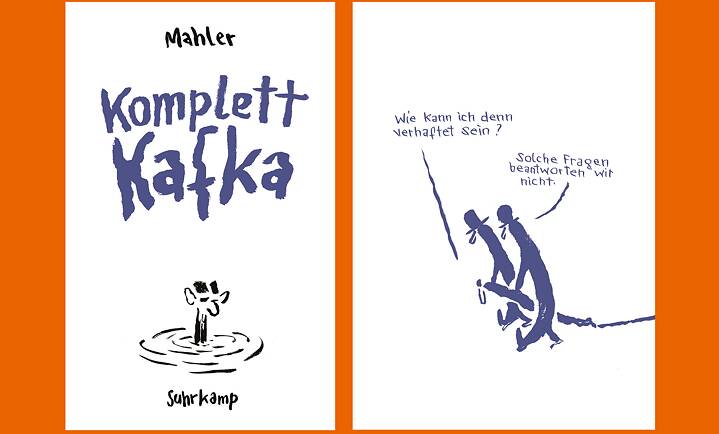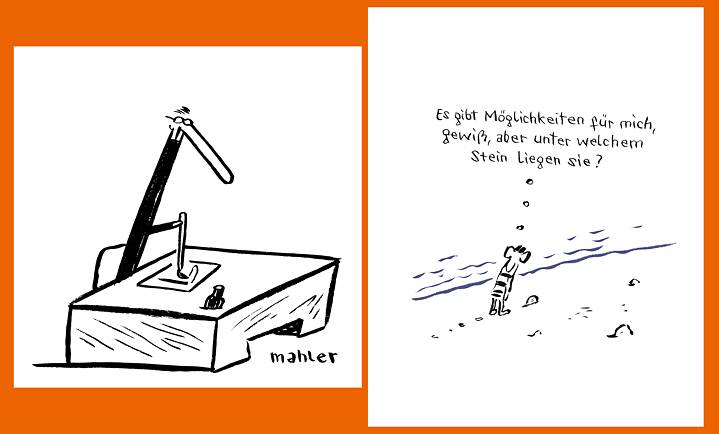Cherrypicker | Literature
Kafka’s Failed Money-Making Scheme
On the hundredth anniversary of his death, Franz Kafka’s life and work are being celebrated and illuminated. In his new graphic novel, illustrator Nicolas Mahler gives them a colourful brilliance – although it’s almost all black-and-white.
By Benedikt Arnold
In 1918, Franz Kafka wrote of himself: “I am the end or the beginning.” Today we know he was the beginning, the start of a new literature, a literature that continues to fascinate readers all over the world. 2024 marks the centenary of Kafka’s death, and it is not surprising that he is being commemorated everywhere in many different ways.
Comic artist Nicolas Mahler has published a book with the megalomanic and playful title Komplett Kafka to mark the centenary. In his graphic novel, Mahler takes a distinctive look at Kafka’s life and work. A personal best-of, or as Mahler says in an interview, the dregs of his year-long occupation with Franz Kafka.
Similarly minimalist
In his book, the Austrian illustrator wanders through Kafka’s life, portraying selected works in an entertaining and precise manner, taking quotes from his diaries and letters and depicting them using a reduced, comical line. Mahler’s figures are minimalist, focussed on their essential features, condensed and expressive at the same time.Viewing Mahler’s drawings, however, a parallel to the master of the grotesque may become apparent to Kafka connoisseurs: For less well-known than Kafka’s writings are his drawings, which are also characterised by a minimalist style and led Kafka to say in a letter to his beloved Felice Bauer, “I was once a great draftsman, you know.”
Nicolas Mahler’s style has often been compared to that of Kafka. He himself did not realise this analogy at first, but he later notes, “Of course you can see similarities, because they are stick figures without facial expressions. It was only when I started work on the Kafka biography that I really became aware of how similar they were, and I found it hugely enjoyable to play around with this idea.”
The graphic novel is an excellent introduction for anyone who wants to take a closer look at Kafka, or for those who think they know Kafka well enough. Mahler illustrates Kafka’s stories such as The Castle, The Metamorphosis, and Amerika with humour and a grotesque sensibility. He doesn’t succumb to the temptation to emphasise the comedy alone and place it at the centre, as is all too often the case in the recent reception of Kafka. Instead, in his drawings Mahler succeeds in expressing the inherent tragedy of the writings.
On the cheap
Nevertheless, the graphic novel is a great pleasure full of surprising anecdotes. Mahler tells the story of Kafka’s money-making idea: Together with his mate Max Brod, he wanted to publish a commercial bestseller series. Kafka wrote, “We had the idea of creating a new type of travel guide. It was to be called BILLIG or ON THE CHEAP. For example, On the Cheap through Switzerland, On the Cheap in Paris and so on.” It would only ever recommend one thing – the cheapest hotel, the cheapest restaurant, the cheapest means of transport. Linked to this was the idea of the On the Cheap language guide, which, given the impossibility of learning a foreign language completely, teaches the wrong thing straight away. In the end, the idea remained just a dream. Talks with publishers failed, and so Kafka did not become a millionaire.Mahler recounts a curious aspect of what is probably Kafka’s most famous novella, The Metamorphosis. Even though the story did not receive favourable press at the time of its publication, it was certainly fan fiction. Karl Brand, a 20-year-old from Prague at the time, was so fascinated and inspired by Kafka’s text that he wrote a sequel to the story entitled The Re-metamorphosis of Gregor Samsa. In it, the dead beetle comes back to life and transforms back into his old self. Unlike the original tale, Karl Brand put more optimism on paper and ended his story with the sentence: “A new life begins!” The tragedy of the story, however, is that Karl Brand fell ill with pulmonary tuberculosis and died in his parents’ Prague flat just nine months after publishing his story.
Relevance beyond borders
Nicolas Mahler draws a colourful, approachable and lively portrait of Franz Kafka in his comic. The Austrian illustrator is thus making a special contribution to the Kafka centenary, the special nature of which has also found favour in other countries: Nicolas Mahler’s comic is being translated into several languages and an exhibition of selected illustrations will be shown worldwide. A fact that proves once again that Kafka’s work remains relevant and inspires people across national borders.Nicolas Mahler: Komplett Kafka
Berlin: Suhrkamp, 2023. 127 p.
ISBN: 978-3-518-47374-0
Read more about Kafka in the current issue of our cultural magazine Zeitgeister.



